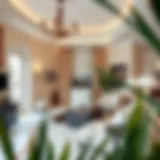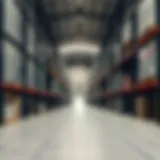Understanding the Dubai Metro Route: A Comprehensive Guide


Intro
The Dubai Metro system stands as a prominent feature of the city’s urban landscape, weaving a web of connectivity that supports its rapid growth and dynamism. With a focus on public transportation, this metro system has effects reaching far beyond just moving passengers from one point to another; it influences real estate, economic growth, and urban development. In this comprehensive guide, we’ll navigate through the various lines and stations of the Dubai Metro, uncovering how its infrastructure shapes the property market and accessibility in one of the world’s most vibrant cities.
In the sections that follow, we will delve into market trends, offer insights into luxury and affordable housing options, and reveal how the process of commuting via the metro can significantly enhance property values. Investors and homebuyers alike will find this analysis integral for informed decision-making in the context of Dubai's real estate.
Market Trends and Insights
Current Market Analysis
Currently, the real estate market in Dubai is witnessing a fluctuation of interest, directly tied to strategic locations near metro stations. Demand for properties close to these metro stops has surged, as proximity translates into not just convenience but enhanced property value. Investors keen on maximizing returns often eye new developments in areas such as Downtown Dubai, Business Bay, and Dubai Marina where the metro provides rapid transit.
A recent report from the Dubai Land Department indicates a steady increase in residential sales, with many buyers favoring properties offering excellent accessibility to metro stations. The shift can be attributed to various factors, including an increase in tourism and a growing expatriate population looking for convenient commuting options.
Historical Trends and Future Predictions
Looking back, the inception of the Dubai Metro in 2009 marked a pivotal shift in how the city's residents navigated daily life. Initially, the property market responded cautiously, but over the years, as the metro expanded, so did property values around its corridors. Notably, areas within walking distance to metro stations have recorded appreciation rates significantly higher than others.
Future predictions suggest that ongoing expansions of the metro network will likely spur further growth in specific neighborhoods, making previously overlooked areas more appealing. As government initiatives align with urban development plans, these insights provide a roadmap for prospective investors, measuring potential growth opportunities across various districts.
Property Listings and Comparisons
Luxury Properties Overview
The luxury real estate market in Dubai is thriving, particularly in areas serviced by the metro. Stalwarts such as the Burj Khalifa and approaches to Palm Jumeirah have witnessed high demand from affluent buyers eager for both aesthetic pleasure and unmatched accessibility. Properties in these locales often boast vertical living spaces, high-end amenities, and breathtaking views of the city.
Market leaders like Emaar and Damac have launched exclusive developments targeting this clientele, ensuring that proximity to the metro is a key selling point. Potential investors should consider key factors, like rental yields and resale potential, especially in luxury segments where the metro enhances desirability.
Affordable Housing Options
On the other end of the scale, the demand for affordable housing near metro stations has also seen a substantial upswing. Areas such as Al Qusais and Al Nahda offer a blend of budget-friendly apartments without sacrificing accessibility. The metro opens up pathways to major business hubs, making these neighborhoods attractive for young professionals and families.
By exploring community-focused developments, buyers can find properties that provide not only affordability but also a community feel, essential for many families exploring options in Dubai.
"Accessibility can drive the desirability of real estate; the more connected, the more valuable!"
Ending
In summarizing the growing influence of the Dubai Metro on property dynamics, it is evident that this modern transportation system plays a vital role in shaping urban living. For buyers, investors, and real estate professionals, understanding the correlation between this network and the property market is crucial. As we see the connectivity of Dubai expand further, it presents a multitude of opportunities worth exploring.
Prolusion to Dubai Metro
The Dubai Metro stands as a remarkable feat of modern engineering and urban planning, weaving through the bustling cityscape of Dubai. Its importance in this guide is not only as a means of transportation but also as an essential backbone of the city’s infrastructure. As we delve into the nuances of the metro system, readers will appreciate how it affects daily life, investment opportunities, and the broader context of urban living in Dubai.
Historical Overview
The roots of the Dubai Metro can be traced back to the early 2000s, when the city embarked on an ambitious journey towards modernization and sustainability. Conceived as part of the Dubai Strategic Plan 2015, the metro was designed to alleviate traffic congestion and promote a greener urban environment. The initial construction phase was no small task; it required a staggering investment and extensive planning to navigate the challenges posed by existing structures and the natural landscape.
The first line, the Red Line, opened its doors to the public in September 2009. It was a groundbreaking moment that set the tone for future developments in public transport. The system expanded significantly with the launching of the Green Line in September 2011, demonstrating the city’s commitment to enhancing connectivity. This history outlines the transformation of Dubai into a globally recognized city that pioneers infrastructure development.
The anticipation that accompanied the metro’s construction was mirrored by the excitement of its impact on real estate. As the metro introduced new areas to commuters, neighborhoods that once languished in relative obscurity blossomed, inviting both local and international investment.
Development Philosophy
The development philosophy of the Dubai Metro reflects a broader vision for sustainable urban growth. The key elements include efficiency, sustainability, and integration.
- Efficiency: At the heart of the metro's design is a focus on reducing travel time for residents and visitors alike. By connecting vital commercial and residential districts, the metro ensures that moving around the city is as hassle-free as possible.
- Sustainability: Dubai acknowledges the necessity for eco-friendly solutions amidst rapid urbanization. The metro operates on a fully automated system, utilizing advanced technologies to minimize energy consumption and reduce carbon emissions. It’s a clear statement of intent: a healthier environment for future generations.
- Integration: Beyond just metro services, the project aims for a seamless transit experience. It integrates with other modes of transport—including buses and water taxis—to form a cohesive public transport network. This aspect enhances not only the user experience but also encourages a larger number of individuals to rely on public transport instead of personal vehicles.
The development philosophy of the Dubai Metro encapsulates an evolutionary step in urban transport. It serves as both a blueprint for future projects and a source of inspiration for cities around the globe striving for balance between progress and sustainability.
"The Dubai Metro illustrates a commitment by the emirate not just to build but to build wisely, bridging communities through connectivity."
In summary, the introduction of the Dubai Metro highlights the effective realization of an ambitious vision. The historical context combined with a solid development philosophy ensures that the metro not only serves as transit but also shapes the urban fabric of Dubai, making it an indispensable element to consider for investors, homebuyers, and urban enthusiasts.


Overview of the Metro Lines
In the bustling urban landscape of Dubai, the metro system stands out as a lifeline that connects various segments of the city. The significance of the metro lines cannot be overstated, as they not only ease mobility for the residents but also drive growth in the real estate sector, impacting property values and accessibility. This overview explores each line and their implications for investors and homebuyers alike.
Red Line Details
The Red Line is the backbone of the Dubai Metro, stretching from Rashidiya to UAE Exchange. Covering approximately 52 kilometers, it plays a pivotal role in accommodating the heavy commuter traffic. Notable stations along this line, such as Burj Khalifa/Dubai Mall, provide easy access to key attractions, bolstering its importance for both residents and tourists.
Key Highlights of the Red Line:
- Accessibility: With over 29 stations, including strategic hubs, the Red Line facilitates easy transfers to other transport modes, enhancing overall connectivity across Dubai.
- Frequent Services: It operates with high frequency, especially during peak hours, ensuring commuters can rely on it to get to their destinations on time.
- Integration with Real Estate: Properties near the Red Line experience a consistent increase in value, making them attractive investments.
In essence, the Red Line is not just a means of transportation; it acts as a conduit for economic activity, significantly shaping the area’s property market.
Green Line Insights
The Green Line offers an alternative route through Dubai, connecting areas less serviced by the Red Line. This line runs from Etisalat to Dubai Creek and primarily serves neighborhoods that are emerging hotspots for development.
Important Aspects of the Green Line include:
- Connection to Key Areas: It links residential areas with commercial districts, which supports the growth of businesses in less developed regions.
- Promoting Sustainable Urban Living: The Green Line emphasizes eco-friendly initiatives and sustainable transport, which aligns with Dubai’s vision of intelligent and green urban planning.
- Real Estate Potential: Areas adjacent to the Green Line are becoming increasingly attractive for developers and investors looking to capitalize on the city’s expanding footprint.
With its focus on emerging neighborhoods, the Green Line symbolizes the ongoing evolution of Dubai’s urban centers, creating varied opportunities for homebuyers and investors.
Future Expansion Plans
The future of the Dubai Metro is promising, with extensive expansion plans on the horizon. Dubai's Roads and Transport Authority (RTA) has announced various projects aimed at making the metro system even more comprehensive.
Here are some anticipated expansions:
- New Lines and Extensions: There are proposals for additional metro lines that will branch out to underserved areas, expanding the network.
- Integration Efforts: Plans also include synergies with tram systems and bus networks to create a seamless travel experience across the city.
- Increased Capacity: Future projects aim to enhance the capacity of existing lines to accommodate burgeoning commuter numbers as Dubai continues to grow.
"Forward-thinking expansion initiatives set the foundation for a more interconnected and efficient Dubai, paving the way for a thriving real estate landscape."
As these plans come to fruition, property valuations are likely to reflect the increased accessibility and interconnectedness that the expanded metro system will bring.
Key Stations Along the Route
The Dubai Metro is not just a mode of transport; it’s a vital artery that enhances urban mobility and connectivity in one of the world’s fastest-growing cities. Key stations along the metro route serve as crucial hubs that facilitate access to major attractions, commercial districts, and residential neighborhoods. Each of these stations is not merely a stop but a gateway to the vast opportunities Dubai offers. Here, we delve into the significance of notable stations, illustrating their roles in improving accessibility and boosting property values.
Burj Khalifa/Dubai Mall Station
Nestled at the base of the iconic Burj Khalifa and adjacent to the sprawling Dubai Mall, this station is more than a transit hub; it’s a destination. The Burj Khalifa/Dubai Mall Station acts as a critical stop for both residents and tourists, threading the needle between leisure and commerce.
The close proximity to these landmarks influences property demand in the surrounding area. High-end residential towers, hotels, and retail spaces thrive nearby, leading to elevated property values. Investors often find this location appealing due to its ability to attract both tourists and commuters alike. With millions visiting the mall annually, it's no surprise that properties in this vicinity are golden eggs in the real estate market. In numbers, a study shows that property prices within a one-kilometer radius of this station can increase by over 25% compared to similar areas farther away.
The very presence of the metro station has nearly doubled pedestrian traffic—signifying its role in the local economy.
Dubai Marina Station
At the heart of one of Dubai’s most vibrant neighborhoods, Dubai Marina Station epitomizes the blend of modernity and lifestyle. This station connects residents directly to the beach, restaurants, and various leisure activities. As a popular residential area, the station attracts a variety of homebuyers—from young professionals to families looking for waterfront living.
The real estate market in Dubai Marina shows how a metro station can enhance a community's appeal. Properties tend to have a higher occupancy rate and command premium rents, particularly as the demand for waterfront views remains sky-high. The emergence of new developments around the station has contributed to an increase in living standards, making it a prime target for investors looking to capitalize on the thriving rental market.
Jumeirah Lake Towers Station
Jumeirah Lake Towers (JLT) Station serves as a strategic link between the financial district and residential areas. It's surrounded by picturesque lakes and greenery, offering a refreshing contrast to Dubai’s typically urban landscape. One can say this area resonates with balance and tranquillity, attracting both professionals and families.
The business community here benefits greatly from the convenience of metro access, which in turn boosts property demand. Flexible work environments have increased interest in the JLT area, with many tenants and buyers favoring easy access to both work and relaxation spots. The station’s role in improving connectivity can lead to property values rising significantly, making it an attractive avenue for investors focusing on the mid-range market.
Dubai International Airport Station
As a gateway to the world, Dubai International Airport Station holds considerable weight in terms of mobility. With tens of millions passing through the airport annually, it's pivotal for connecting travelers to the city and further afield. This unique position influences nearby property markets, especially for businesses catering to tourists and expatriates.


The station’s accessibility has made property around the airport highly desirable. Hotels, serviced apartments, and short-term rentals tend to see a steady occupancy rate, presenting a lucrative opportunity for real estate developers. Furthermore, the location benefits from the significant influx of international visitors—cementing its importance in Dubai’s economy.
In summary, the key stations along the Dubai Metro line serve as essential connectors, enhancing accessibility, raising property values, and driving local economies. They reflect the ingenuity behind urban planning in Dubai, linking communities and creating vibrant hubs of activity.
Impact on Real Estate Development
The impact of the Dubai Metro on real estate development is profound and multifaceted. This modern transport system does more than just whisk people from point A to B; it fundamentally alters the landscape of property investment and urban growth. The integration of metro lines enhances the appeal of surrounding neighborhoods, making them more desirable for both residential and commercial developments. Investors, realtors, and homebuyers should consider these dynamics carefully when analyzing the potential of property acquisitions in Dubai.
Property Values Along Metro Lines
The presence of a metro line can be a goldmine for property values in its vicinity. Properties located near metro stations frequently see an uptick in value. According to various studies, proximity to efficient public transit is one of the key factors influencing property prices. Due to the accessibility offered by the metro, homes and businesses situated a stone's throw away from stations tend to command higher prices than those further afield.
For instance, properties near the Burj Khalifa/Dubai Mall Station tend to maintain their value, even in fluctuating markets, because of the constant influx of tourists and residents. This can create a ripple effect on neighboring areas, leading to enhanced property markets that flourish harmoniously with the metro's ongoing growth.
Factors influencing property values include:
- Accessibility to major business districts
- Demand from a growing expat community
- Increased foot traffic in the area
- Enhanced urban infrastructure
Accessibility Boost for Neighborhoods
The Dubai Metro significantly enhances accessibility in varied neighborhoods, which can be a game-changer for residents and businesses alike. In a city where traffic can frequently transform into a daunting hindrance, the metro simplifies commuting. This convenience can contribute not only to rising property values but also to attracting businesses looking to tap into a larger customer base.
Areas that might have been bypassed previously are seeing revitalization. For example, neighborhoods like Al Quoz and Dubai Marina have witnessed an upsurge in interest from homebuyers, thanks to their connectivity with the rest of the city. The ease of transit from these areas reduces not only travel time but fosters a sense of community as people engage more with their surroundings, further improving neighborhood dynamics.
Investment Opportunities Linked to Metro
Beyond the immediate increase in property values and improved community accessibility, the Dubai Metro paves the way for various investment opportunities. Real estate developers often leverage the metro's arrival as a marketing boon, promoting their projects as key players in an accessible and vibrant urban environment.
Potential investment considerations include:
- Mixed-use developments that combine residential, commercial, and leisure spaces close to metro stations.
- Affordable housing initiatives targeting commuters seeking convenient living arrangements, these projects can flourish near transport links.
- Retail spaces that benefit from increased foot traffic, catering to both locals and visitors.
Furthermore, investors should keep an eye on the expansion plans of the metro. Future lines can alter existing neighborhoods and uncover new opportunities that were previously unforeseen. As the city grows, these will continue to offer lucrative avenues for strategic investments in real estate.
User Experience and Connectivity
The experience of using the Dubai Metro isn’t just about reaching a destination; it encapsulates a broader narrative of urban mobility and connectivity. The metro system serves not only the day-to-day commuter but also tourists, thereby knitting a fabric of accessibility across this sprawling city. It’s essential to assess various elements such as fare structures, reliability, frequency, and how well the metro integrates with other transport systems.
Fare Structure and Ticketing
The fare system in the Dubai Metro is designed with clarity and convenience in mind. Ticketing options include a variety of choices tailored to meet different travel needs, ranging from single journey tickets to daily or monthly passes. For instance, the NOL card acts as a gateway to seamless travel, allowing preloaded fares that can be tapped at entry and exit gates.
Additionally, it’s noteworthy that the fare structure is relatively affordable by international standards. A journey can cost as low as AED 3, depending on the zones traversed.
"The intuitive ticketing system encourages users to embrace public travel, adding to the efficiency of urban life in Dubai."
Some passengers might initially feel apprehensive about using the automated ticket machines, but these devices have multilingual interfaces that make it easier for international visitors. It’s this focus on user experience that fosters a more welcoming environment for everyone.
Reliability and Frequency
When evaluating an urban transport system, reliability stands as a crucial metric. The Dubai Metro prides itself on punctuality and consistency; trains are scheduled to arrive every few minutes during peak hours and maintain efficient service throughout the day. This high frequency minimizes wait times and facilitates easy transfers — especially important in a city where temperatures can soar.
Moreover, the system operates with advanced technology that allows real-time updates about train arrivals. Displays at stations and inside trains keep passengers informed. On a day when traffic chaos reigns on the roads, the metro remains a dependable lifeline.
Integration with Other Transport Systems
The ability of the Dubai Metro to weave seamlessly into the broader transport network is another facet of user experience worth discussing. Connections to several important hubs enhance its role in the city’s transport schema.
For example, at select stations, passengers can interchange with bus services or taxis, providing a holistic transit experience. This connectivity bridges gaps for those commuting from peripheral areas or districts not directly served by the metro. Additionally, more recently, efforts have been ramped up to ensure proposed tram and boat services synchronize well with metro schedules, showcasing a commitment to creating a unified transport ecosystem.
Finale
User experience and connectivity form the backbone of Dubai’s urban transport ethos. With thoughtful fare structures, unwavering reliability, and intelligent integration with other transport modes, the metro isn’t just about getting from point A to B; it’s about enriching lives through mobility. As investors, homeowners, and real estate professionals scrutinize these dynamics, understanding the interplay between user experience and urban connectivity will emerge as essential for navigating the Dubai property landscape.


Social and Environmental Considerations
The Dubai Metro is more than just a transportation system; it embodies a set of values aimed at uplifting the community and nurturing the environment. With the rapid development of urban spaces, social and environmental considerations have become pivotal elements in ensuring sustainable growth. For investors and homebuyers alike, recognizing the balance between development and environmental care can yield insights into the future performance of property values along the metro routes.
Sustainability Initiatives
In recent years, sustainability has become a cornerstone of urban transport planning. The Dubai Metro has taken significant steps toward minimizing its carbon footprint. One of the standout features of the metro system is its energy-efficient design.
- Energy Efficiency: The entire metro system operates on an electrified rail network that relies heavily on renewable energy.
- Solar Power Utilization: Solar panels are installed at various stations, contributing to the overall energy needs of the metro, reducing reliance on non-renewable sources.
- Water Conservation: Innovative designs include rainwater harvesting systems to sustain landscaping and reduce the demand on municipal water.
These initiatives not only reduce operational costs but also appeal to eco-conscious investors keen on properties that add to their portfolio's sustainability narrative. The alignment of urban transport with green practices enhances the overall living environment, making areas close to the metro more desirable.
Community Development Goals
The metro's influence extends beyond transit; it significantly contributes to community development. One of the primary goals of the Dubai Metro is to foster social inclusivity and enhance urban connectivity.
- Affordable Housing Accessibility: Projects located near metro stations often include affordable housing, making it feasible for a diverse demographic to live close to their workplaces.
- Employment Opportunities: As the metro system enhances access to various commercial centers, it naturally promotes job creation across multiple sectors.
- Community Engagement: Dubai Metro authorities have been actively involved in community events, ensuring that local voices are considered in further developments.
Through such initiatives, the Dubai Metro plays a catalytic role in transforming neighborhoods. By improving access and integrating community needs into urban planning, it's creating a dynamic environment where property values can appreciate steadily, driven by both demand for housing and quality of life improvements.
"Investing in areas with robust transit connectivity usually ensures that you are not just investing in property, but in community vitality."
Finale of Considerations
In summary, the social and environmental considerations of the Dubai Metro are crucial for understanding its role in urban development. By emphasizing sustainability and community goals, the metro system serves as a model for future transport projects. For those involved in real estate, being aware of these layers adds depth to investment decisions, aligning with broader trends that prioritize responsible growth and community well-being.
For more on sustainable urban transport and development, consider exploring resources on Wikipedia and initiatives from local governmental sites like Dubai.gov.
Challenges and Limitations
Addressing the challenges and limitations of the Dubai Metro is crucial for understanding its full impact on the urban framework of the city. While the metro system greatly contributes to public transport efficiency and urban mobility, it is not without its share of obstacles. Recognizing these hurdles can give investors and homebuyers insight into the long-term sustainability and adaptability of the metro system, allowing more informed investment decisions.
Operational Hurdles
The Dubai Metro faces several operational hurdles that can impede its effectiveness. Firstly, maintaining a high level of reliability is paramount. Even a slight delay in service could cause considerable disruptions, especially during peak hours. The system boasts a robust structure, but aging technology and wear and tear can lead to significant maintenance concerns that require attention.
Moreover, the vast and complex layout can lead to inefficiencies in route management, making it challenging to streamline operations across the network. Here are a few key operational hurdles:
- Technical Malfunctions: Periodic technical failures may affect train operations, leading to delays and a decline in user satisfaction.
- Human Resource Challenges: Staffing can sometimes be an issue, particularly in maintaining a trained workforce capable of addressing various operational challenges.
- Safety Protocols: Ensuring safety is non-negotiable, but the need to upgrade safety measures constantly can stretch resources thin, both financially and operationally.
While these operational issues present clear challenges, they also create opportunities for innovation and improvement. Addressing these concerns proactively may set the stage for a more resilient transit framework.
Future Growth Limitations
Looking ahead, the future growth of the Dubai Metro may face limitations due to various factors. Although plans for expansion are on the drawing board, certain constraints could hinder rapid growth. One major aspect is funding. All ambitious expansion projects will require a substantial capital injection, and finding investors willing to back these enhancements is paramount.
Additionally, urban planning must align with metro expansion. As the city grows, so must the infrastructure that supports it. The integration of new areas into the existing metro network may require negotiations and collaborations with various stakeholders, which can take time and complicate the situation. Some limitations include:
- Physical Space Constraints: Areas with high-density developments may not have ample space for new stations or tracks, making it challenging to expand the metro system's reach effectively.
- Regulatory Requirements: Navigating through bureaucratic landscapes can slow down the approval processes required to initiate expansion plans.
- Competition from Other Modes of Transport: As road networks and alternative transit solutions like shared cab services grow, competing for riders’ attention might become more challenging for the metro.
End
As we wrap up this comprehensive guide to the Dubai Metro route, it becomes clear how significant this transport system is for the urban fabric of the city. The metro not only alleviates traffic but also has a profound impact on real estate dynamics and social infrastructure. Understanding the myriad elements of the metro—from the busy Red Line, connecting major hubs, to the emerging potential of the Green Line—reveals a layered tapestry of opportunities and considerations for various stakeholders, including investors, realtors, homebuyers, and developers.
Summary of Key Insights
A few key points are worth summarizing:
- Integration with Urban Development: The growth and expansion of the Dubai Metro are tightly interwoven with the city's overall urban planning. Key stations often signify prime real estate locations, driving property values and attractiveness for investors.
- Accessibility and Community Engagement: The metro enhances accessibility, connecting various communities, thus fostering engagement and social cohesion. Areas adjacent to metro stations are receiving attention not only from homeowners but also developers and businesses seeking to capitalize on the increased foot traffic.
- Sustainability Considerations: Investments in the metro reflect a commitment to sustainable public transport. The focus on reducing carbon footprints while promoting urban mobility aligns with global trends towards greener cities.
In short, the Dubai Metro is not just a transport system; it's a catalyst for evolution within the city's real estate and community living landscapes.
Future Outlook for Dubai Metro
Looking ahead, the Dubai Metro is poised to continue evolving. With ongoing expansion plans and future initiatives, stakeholders can anticipate several trends:
- Further Expansion: New lines are in the pipeline, which will enhance connectivity across the emirate. Regions currently underserved are likely to see significant transformations, making them appealing for both residential and commercial development.
- Tech Integration: The inclusion of smart technology—like contactless payments and real-time updates—will likely improve user experience, making the metro an even more attractive option for commuters.
- Increased Investment Opportunities: As the metro expands, investors should keep an eye on emerging neighborhoods. The metro's influence on property value is expected to grow, heralding ripe opportunities for those who act early.
The future of the Dubai Metro shines brightly, promising innovation and growth. For investors and real estate enthusiasts, this transport network is not merely a means of getting from point A to point B; it is a gateway to understanding the evolution of Dubai itself.















